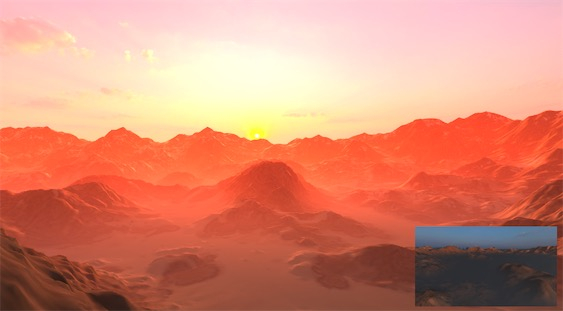|
|
资源信息 Asset Information
| 资源名称: | DeepSky Haze (发帖教程) |
| 版本: | 无 (版本) |
| 资源等级: | 6 |
| 资源格式: | .unitypackage (链接失效请点击帖子右下方举报通知管理员) |
|---|
| 资源大小: | 90MB (默认:MB) |
|---|
| 下载地址: | 请先登录 (购买积分) |
|---|


如果你已经熟悉大气散射的工作原理,你可以跳过这一节。另外,这里有一些关于由DeepSky霾模拟的光散射类型的背景。
当光穿过大气层时,它会被空气中的各种粒子击中并散射;其中一些光最终会飞向我们的视野。当粒子很小的时候,散射量会随着不同波长的光而变化。这就产生了经典的天空蓝色:蓝色波长比绿色和红色散射得更多,所以更多的蓝光被反射到我们的视野中。当光在日出/日落穿越更多的大气层时,蓝色的光几乎完全散去,形成经典的红色/橙色天空。这种类型的散射被称为瑞利散射,也解释了遥远物体的蓝色。在DeepSky霾中,这是由空气参数控制的。
当粒子较大时(如尘埃或水蒸气颗粒),散射不依赖于波长,光作为一个整体被散射。这是在尘土飞扬的日子里在太阳周围看到的白色/黄色的“雾霾”,通常在离地面较近的地方(约1500米以下)发现。这被称为Mie散射,是由霾参数控制的。
散射的数量也取决于光的传播方向和视图方向之间的角度。Mie散射具有很强的各向异性,这意味着它在某个方向或另一个方向更明显。光向它原来行进的方向散射得更多,这被称为前向散射。后向散射是指光线以相反的方向向光源散射。瑞利散射不是很各向异性,所以为了性能,它被认为是在所有方向上均匀的散射(各向同性散射)。
除了大尺度的大气光散射,DeepSky Haze还可以模拟来自点光源和点光源的局部散射,比如在一个有烟的房间。这是用与大气霾完全相同的物理方法计算的,使用相同的各向异性Mie散射方法。
==
If you are already familiar with how atmospheric scattering works you can skip this section. Otherwise, here’s some background on the types of light scattering simulated by DeepSky Haze.
As light travels through the atmosphere, it can hit and be scattered by the various particles in the air; some of this light can then end up travelling towards our view. When the particles are very small, the amount of scattering changes for different wavelengths of light. This causes the classic blue colour of the sky: blue wavelengths scatter more than green and red so more of the blue light is bounced into our view. As the light travels through more of the atmosphere at sunrise/sunset the blue light is almost completely scattered away, resulting in classic red/orange skies. This type of scattering is known as Rayleigh scattering, and accounts for the blue colour of distant objects as well. In DeepSky Haze this is controlled by the Air parameters.
When the particles are large (such as grains of dust or water vapour) then the scattering is not dependent on wavelength and the light is scattered as a whole. This is the white/yellow ‘haze’ seen around the sun on a dusty day and is typically found closer to the ground (below ~1500 metres). This is known as Mie scattering, and is controlled by the Haze parameters.
The amount of scattering can also depend on the angle between the direction the light is travelling in and the direction of the view. Mie scattering is strongly anisotropic, meaning it is more pronounced in one direction or another. Light scattered more towards the direction it was original travelling is known as forward scattering. Back scattering is when the light is scattered in the opposite direction back towards the light source. Rayleigh scattering isn’t very anisotropic so for performance it is considered to scatter equally in all directions (isotropic scattering).
In addition to the large scale atmospheric light scattering, DeepSky Haze can also simulate the local scattering from spot and point light sources, such as in a smoky room. This is calculated in exactly the same physically-based manner as the atmospheric haze, using the same anisotropic Mie scattering method.
|
本帖子中包含更多资源
您需要 登录 才可以下载或查看,没有账号?立即注册
×
|

